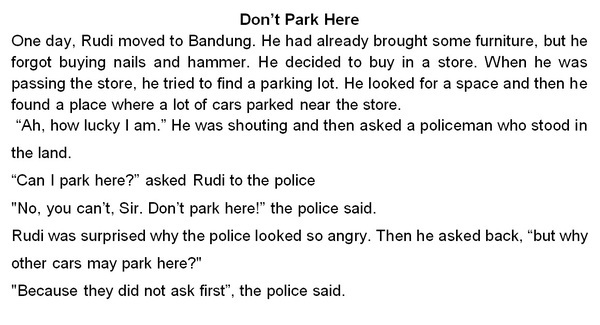Read more
Understanding Functional Text: Spoof
Objectives
Understanding the meaning of short
functional text and monologue form of spoof in the context of daily life
Learn about it!
You have already learned about some
kinds of text such as narrative text and recount text. In this lesson, you will
learn about how to understand a short functional text of spoof text form.
SPOOF
TEXT
Spoof text is a text that tells
about a short story which cannot be predicted in the end, but it has funny
ending. Spoof text commonly contains funny
wordplay which has sense of humor. People use this kind of text to make a joke.
So, if you want to make a spoof text, you need to have a humorous style.
Social
Function of Spoof Text
Spoof text aims to entertain or
humor the readers with a twisting or unpredictable ending. It focuses on humor story than taking a lesson. It is made
for entertaining and the funny thing will be found at the end of the story.
Generic
Structure of Spoof Text:
Even though the story is short, but
it has some generic structures which should be noticed as follows:
- Orientation
As in narrative and recount text, spoof text has also orientation which introduces the characters of the story, a place where it happens, and when it happens. - Events
This part tells about the sequences or chronological events of the story. Several events are arranged in chronological way in order that the reader can read it well. - Twist
This is the last part. It is an unpredictable plot which is put in the end of the story to amuse the reader. The readers cannot predict the plot, so the writer put the twist in the end of the story. The story cannot be called as a poof text if there is not a twist. Thus, it can be concluded that twist is the most important thing in making a spoof story.
Language
Feature of Spoof Text
In writing a spoof text, you should
also pay attention to its language feature.
- Focusing on participant like as animals, people, or
certain things
- Using action verb (came, decided, got, etc.)
- Using past tense to tell the past events.
- Using of adverbial phrases of time and place such as
one day, in the hospital, in the store, etc.
- Telling about the sequences of events in the correct
order.
- Using of direct speech or indirect speech for the
conversations.
Do you understand?
Example of Spoof Text:
After reading the story above, some
of you may think hard to understand the twist. You need a sense of humor to
understand the story to catch the humor in the twist.
Keypoints
To sum up the lesson above, spoof
text is:
• A story which has unpredictable and funny ending.
• Aims to amuse the readers through the story.
• Has three parts in generic structures; orientation, events, and twist.
• Uses past tense because it tells about past event.
• Has the important thing in the story to make punch line which is called as twist. It is put in the end of the story.
• A story which has unpredictable and funny ending.
• Aims to amuse the readers through the story.
• Has three parts in generic structures; orientation, events, and twist.
• Uses past tense because it tells about past event.
• Has the important thing in the story to make punch line which is called as twist. It is put in the end of the story.
Lets Practice!
Jawablah pertanyaan-pertanyaan berikut dengan jujur dan bertanggungjawab!
| No. | Pertanyaan | Jawaban | |
|---|---|---|---|
| 01. | Saya mengetahui arti kata-kata pada pada teks di atas |
Ya | Tidak |
| 02. | Saya bisa mengucapkan kata-kata sesuai dengan audio/video yang disajikan |
Ya | Tidak |
| 03. | Saya bisa memperagakan percakapan dengan membaca teks yang tersedia |
Ya | Tidak |
| 04. | Saya bisa memperagakan percakapan dengan sedikit membaca teks |
Ya | Tidak |
| 05. | Saya bisa memperagakan tanpa membaca teks |
Ya | Tidak |
| 06. | Saya bisa memperagakan tanpa membaca teks disertai dengan variasi baru atau pengembangan teks |
Ya | Tidak |
| 07. | Saya bisa membuat karya video terkait dengan percakapan yang diperagakan |
Ya | Tidak |
| 08. | Saya bisa membuat video dan telah disosialisasikan pada sosial media yang saya miliki |
Ya | Tidak |
Bila ada jawaban "Tidak", maka segera lakukan review pembelajaran, terutama pada bagian yang masih "Tidak".
Bila semua jawaban "Ya", maka Anda dapat melanjutkan ke pembelajaran berikutnya.
Buatlah jurnal harian untuk membantumu dalam mempercepat proses pembelajaran dengan menjawab soal evaluasi diri berikut ini.
- Apakah yang kamu telah pelajari pada bagian ini?
- Apa yang menarik pada sesi ini?
- Apa kendala yang kamu alami?
- Apa yang kamu lakukan untuk mengatasi kendala tersebut?
Informasi lainnya yang terkait dapat diakses pada tautan berikut ini





